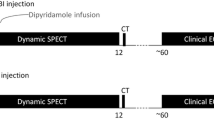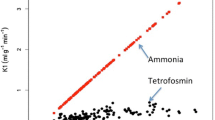Abstract
Background
Measurement of myocardial blood flow (MBF) is feasible using SPECT imaging but the acquisition requires more time than usual. Our study assessed the impact of reducing acquisition times on the accuracy and repeatability of the uptake rate constant (K1).
Methods
Twenty-nine patients underwent two rest/stress studies with Tc-99m-tetrofosmin 18 ± 13 days apart, using a one-day rest/stress dynamic SPECT imaging protocol with a solid-state cardiac camera. A 5-minute static image was acquired prior to tracer injection for subtraction of residual activity, followed immediately by 11-minute of list-mode data collection. Static image acquisition times of 0.5, 1, and 3 minutes and dynamic imaging times of 5, 7, and 9 minutes were simulated by truncating list-mode data. Images were reconstructed with/without attenuation correction and with/without motion correction. Kinetic parameters were calculated using a 1-tissue-compartment model.
Results
K1 increased with reduced dynamic but not static imaging time (P < 0.001). The increase in K1 for a 9-minute scan was small (4.7 ± 5.3%) compared with full-length studies. The repeatability of K1 did not change significantly (13 ± 12%, P > 0.17).
Conclusions
A shortened imaging protocol of 3-minute (rest) or 30-second (stress) static image acquisition and 9 minutes of dynamic image acquisition altered K1 by less than 5% compared to a previously validated 11-minute acquisition.




Similar content being viewed by others
Abbreviations
- AC:
-
Attenuation correction
- K1:
-
Uptake rate constant
- MBF:
-
Myocardial blood flow
- MC:
-
Motion correction
- MFR:
-
Myocardial flow reserve
- NC:
-
No attenuation correction
- NMC:
-
No motion correction
- SPECT:
-
Single-photon emission computed tomography
References
Gould KL, Johnson NP, Bateman TM, Beanlands RS, Bengel FM, Bober R, et al. Anatomic versus physiologic assessment of coronary artery disease: Role of coronary flow reserve, fractional flow reserve, and positron emission tomography imaging in revascularization decision-making. J Am Coll Cardiol 2013;62:1639–53. https://doi.org/10.1016/J.JACC.2013.07.076.
Schindler TH, Quercioli A, Valenta I, Ambrosio G, Wahl RL, Dilsizian V. Quantitative assessment of myocardial blood flow—Clinical and research applications. Semin Nucl Med 2014;44:274–93. https://doi.org/10.1053/J.SEMNUCLMED.2014.04.002.
Murthy VL, Naya M, Foster CR, Hainer J, Gaber M, Di Carli G, et al. Improved cardiac risk assessment with noninvasive measures of coronary flow reserve. Circulation 2011;124:2215–24. https://doi.org/10.1161/CIRCULATIONAHA.111.050427.
Herzog BA, Husmann L, Valenta I, Gaemperli O, Siegrist PT, Tay FM, et al. Long-term prognostic value of 13N-ammonia myocardial perfusion positron emission tomography. Added value of coronary flow reserve. J Am Coll Cardiol 2009. https://doi.org/10.1016/j.jacc.2009.02.069.
Bocher M, Blevis IM, Tsukerman L, Shrem Y, Kovalski G, Volokh L. A fast cardiac gamma camera with dynamic SPECT capabilities: Design, system validation and future potential. Eur J Nucl Med Mol Imaging 2010;37:1887–1902. https://doi.org/10.1007/s00259-010-1488-z.
Slomka PJ, Patton JA, Berman DS, Germano G. Advances in technical aspects of myocardial perfusion SPECT imaging. J Nucl Cardiol 2009;16:255–76. https://doi.org/10.1007/s12350-009-9052-6.
Wells RG, Marvin B, Poirier M, Renaud J, DeKemp RA, Ruddy TD. Optimization of SPECT measurement of myocardial blood flow with corrections for attenuation, motion, and blood binding compared with PET. J Nucl Med 2017;58:2013–9. https://doi.org/10.2967/jnumed.117.191049.
Nkoulou R, Fuchs TA, Pazhenkottil AP, Kuest SM, Ghadri JR, Stehli J, et al. Absolute myocardial blood flow and flow reserve assessed by gated SPECT with cadmium-zinc-telluride detectors using 99mTc-Tetrofosmin: Head-to-head comparison with 13N-ammonia PET. J Nucl Med 2016;57:1887–92. https://doi.org/10.2967/jnumed.115.165498.
Shrestha U, Sciammarella M, Alhassen F, Yeghiazarians Y, Ellin J, Verdin E, et al. Measurement of absolute myocardial blood flow in humans using dynamic cardiac SPECT and 99mTc-tetrofosmin: Method and validation. J Nucl Cardiol 2017;24:268–77. https://doi.org/10.1007/s12350-015-0320-3.
Dorbala S, Ananthasubramaniam K, Armstrong IS, Chareonthaitawee P, DePuey EG, Einstein AJ, et al. Single photon emission computed tomography (SPECT) myocardial perfusion imaging guidelines: Instrumentation, acquisition, processing, and interpretation. J Nucl Cardiol 2018;25:1784–846. https://doi.org/10.1007/s12350-018-1283-y.
Ben Bouallegue F, Roubille F, Macia J-C, Cung TT, Macia JC, Gervasoni R, et al. SPECT myocardial perfusion reserve in patients with multivessel coronary disease: Correlation with angiographic findings and invasive fractional flow reserve measurements. J Nucl Med 2015;56:1712–17. https://doi.org/10.2967/jnumed.114.143164.
Agostini D, Roule V, Nganoa C, Roth N, Baavour R, Parienti JJ, et al. First validation of myocardial flow reserve assessed by dynamic 99mTc-sestamibi CZT-SPECT camera: Head to head comparison with 15O-water PET and fractional flow reserve in patients with suspected coronary artery disease. The WATERDAY study. Eur J Nucl Med Mol Imaging 2018;45:1079–90. https://doi.org/10.1007/s00259-018-3958-7.
Ma R, Wang L, Wu D, Wang M, Sun X, Hsu B, et al. Myocardial blood flow quantitation in patients with congestive heart failure: Head-to-head comparison between rapid-rotating gantry SPECT and CZT SPECT. J Nucl Cardiol 2019. https://doi.org/10.1007/s12350-019-01621-2.
Klein R, Renaud JM, Ziadi MC, Thorn SL, Adler A, Beanlands RS, et al. Intra- and inter-operator repeatability of myocardial blood flow and myocardial flow reserve measurements using rubidium-82 pet and a highly automated analysis program. J Nucl Cardiol 2010;17:600–16. https://doi.org/10.1007/s12350-010-9225-3.
Johnson NP, Gould KL. Integrating noninvasive absolute flow, coronary flow reserve, and ischemic thresholds into a comprehensive map of physiological severity. JACC Cardiovasc Imaging 2012;5:430–40. https://doi.org/10.1016/J.JCMG.2011.12.014.
Ruddy TD, Clackdoyle D, Carey C, Marvin B, DeKemp RA, Wells RG. Repeatability of SPECT myocardial blood flow with tetrofosmin. J Am Coll Cardiol 2018;71:A1494.
Disclosures
JD has no conflicts of interest to disclose. TDR and RGW have received research grant support from GE Healthcare, Inc.
Author information
Authors and Affiliations
Corresponding author
Additional information
Publisher's Note
Springer Nature remains neutral with regard to jurisdictional claims in published maps and institutional affiliations.
The authors of this article have provided a PowerPoint file, available for download at SpringerLink, which summarizes the contents of the paper and is free for re-use at meetings and presentations. Search for the article DOI on SpringerLink.com.
The authors have also provided an audio summary of the article, which is available to download as ESM, or to listen to via the JNC/ASNC Podcast.
Electronic supplementary material
Below is the link to the electronic supplementary material.
Rights and permissions
About this article
Cite this article
Do, J., Ruddy, T.D. & Wells, R.G. Reduced acquisition times for measurement of myocardial blood flow with 99mTc-tetrofosmin and solid-state detector SPECT. J. Nucl. Cardiol. 28, 2518–2529 (2021). https://doi.org/10.1007/s12350-020-02048-w
Received:
Accepted:
Published:
Issue Date:
DOI: https://doi.org/10.1007/s12350-020-02048-w




